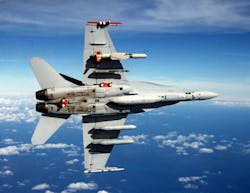Boeing to provide airborne tactical data link to provide remote-control mode for land-attack missile
PATUXENT RIVER NAS, Md. – U.S. Navy smart munitions experts are asking the Boeing Co. to provide secure airborne data links to help guide Stand-off Land Attack Missile-Expanded Response (SLAM-ER) to their targets under terms of a $9.2 million order announced Thursday.
Officials of the Naval Air Systems Command at Patuxent River Naval Air Station, Md., are asking the Boeing Defense, Space & Security segment in St. Louis to provide 36 SLAM-ER AN/AWW-13 advanced data link pods for the government of Saudi Arabia.
The pilots of launch aircraft can guide SLAM-ER missiles to their targets via this secure tactical data link. SLAM-ER can launch from the Navy F/A-18 Super Hornet and the U.S. Air Force's F-15E Strike Eagle.
The AGM-84H/K SLAM-ER is a stand off precision-guided, air-launched cruise missile from Boeing for the U.S. armed forces and their allies. The missile can attack moving and stationary land and sea targets from as far away as 155 nautical miles.
The can be go into remote-control mode while in flight via the AN/AWW-13 data link, and can re-direct to alternative targets after launch if the original targets are destroyed or no longer a threat.
The SLAM-ER missile is 14.3 feet long, 13 inches in diameter, and weighs 1,487 pounds. It is a derivative of the Boeing Harpoon anti-ship missile, which can attack land and sea targets. It relies on the Global Positioning System (GPS) and infrared imaging for its navigation and control.
SLAM-ER missiles obtained initial operating capability in June 2000. They can launch from the F/A-18 Hornet, F/A-18 Super Hornet, and the U.S. Air Force's F-15E Strike Eagle. The missile carries an 800-pound explosive warhead, and uses an inertial navigation system supplemented by GPS, with infrared homing terminal guidance.
For more information contact Boeing Defense, Space & Security online at www.boeing.com/company/about-bds, or Naval Air Systems Command at www.navair.navy.mil.
About the Author
John Keller
Editor-in-Chief
John Keller is the Editor-in-Chief, Military & Aerospace Electronics Magazine--provides extensive coverage and analysis of enabling electronics and optoelectronic technologies in military, space and commercial aviation applications. John has been a member of the Military & Aerospace Electronics staff since 1989 and chief editor since 1995.
